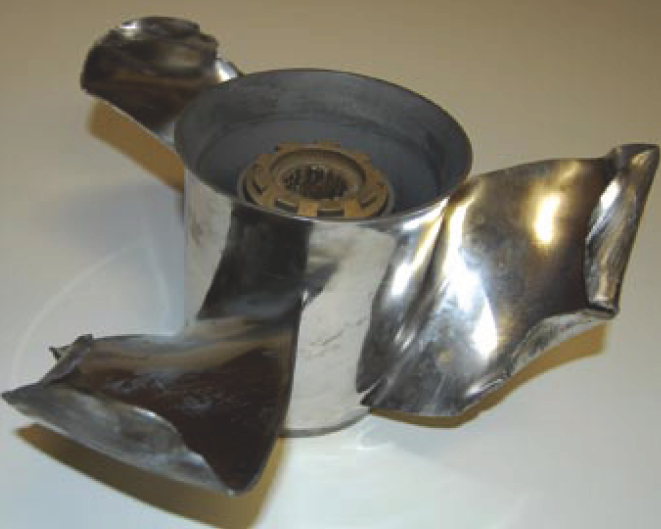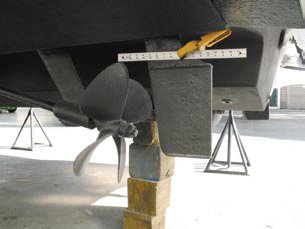Can An Outboard Motor Propeller Ding Be Repaired
Fixing Boat Propeller Problems
Here's how to diagnose and remedy common issues.

Results of hit a rock or a hard place.
With all due respect to the captain, the propeller drives the gunkhole. Its condition determines how fast you go, how much fuel you burn, how long your engine will last, how smoothly your gunkhole rides, how quickly yous pull a wakeboarder out of the water, and maybe even if you'll get back to the dock at the end of the twenty-four hours.
Very few marinas or boat dealers fix propellers themselves; information technology's just too complicated. Your marina sends your prop to a prop shop or you lot tin can visit one yourself. Brand sure that store is reputable, preferably a member of the National Marine Propeller Association, the only organization in the globe that provides grooming and certification for the propeller-repair industry. Gone are the days when props could be repaired with an anvil, a welding machine, and a glaze of paint. Today's props require trained technicians to brand them run correct. While prop makers today evangelize accurately sized props, there is nonetheless much that can exist done to fine-tune them for a particular application. So, take a peek at your propeller. Here are some of the things to wait for.
Flat Tore Up
This is pretty piece of cake to identify. Look for damaged and bent blades and chunks of metallic missing. The design of most propellers these days is very sophisticated, and so damage makes your boat slower and less fuel-efficient. Shine operation is also compromised, which could damage expensive engine parts such as seals, motor mounts, bearings and struts, and drive shafts. If it looks damaged, it is, and should be repaired or replaced immediately.
Looks Good, Works Desperately
In that location are several versions of this. 1 is the "spray tin can recondition." You've probably seen this if you've looked at used boats. All that shiny paint looks dandy, so the prop must have been just repaired or might even be make new. Look more than closely and you'll see edges where the old pigment ends and new paint begins. That's a sure sign that somebody's trying to hide something. Y'all might come across little bends or nicks in the blade tip border or scratches in the surface. A good prop shop won't leave that backside. Plan on fixing or replacing that prop before you run the boat.
Look for repair numbers stamped on the prop. They're hands distinguishable from original function numbers. On aluminum props, you lot may see black "pot metal" filler or porosity from a welding repair, areas that are prone to failure. A repaired prop isn't a bad matter just it'south something y'all should notice so you're not disillusioned when something that looks good goes bad.
Often, particularly with inboards, information technology's difficult to see a big bend that starts at the root of the blade where it meets the hub. All blades await the same and at that place's no obvious impairment but i or ii may be completely out of "index," which is the spacing between blades, or "track," the relative height of each point. On a iv-blade prop, for example, each bespeak on each blade should be at a 90-degree angle and at the same relative height as the same point on a neighboring bract. It'southward difficult to see this, which is a skilful reason to have your props checked every fourth dimension you lot haul your boat or when at your dealer for regular service. Most prop shops do inspections for little or no charge.
Lilliputian Crack? Large Bad Is Next

If not fixed, a cracked bract will pause off and the prop becomes scrap.
Ignoring tiny nicks in the propeller edge is a large deal. Those nicks tin can create stress risers, areas that are more prone to crack equally the propeller blade works through the water. Yous can polish out those areas yourself with a file, but be careful not to grind also much. You'll alter the blade geometry and kill efficiency. All-time to let a professional handle that.
Many stainless-steel props are heat treated to meliorate strength, a process that can make them breakable and susceptible to cracks. Advisedly inspect stainless props and expect for hairline cracks, especially in the leading and trailing edges. Most props so affected can be repaired, but if y'all don't prepare it, you'll finish up losing the blade, damage that cannot be repaired. Prevention costs much less than the cure.
Worn Won't Work
All the blades look the same, and then what'south the trouble? Ofttimes, they're all worn evenly. Wait for blades that aren't naturally rounded at the tip or are worn to a point. Experience the edges, simply exist careful. Habiliment makes them sharp. On the other hand, the tips may be particularly blunt on the leading border, where the prop makes first contact. Paint worn evenly is too a clue.
If you know the design diameter of your propeller, you tin eyeball its actual dimension by measuring from the center of the hub to the tip of one bract (the radius) and multiply past two to get the gauge bore. Diameter and blade expanse are two of the virtually critical aspects of propeller pattern. Missing material causes higher rpm and diminished efficiency, potentially damaging the engine at worst, and slowing the boat and using more fuel at best. A prop shop can build upward diameter and bract area to original specs. If too much is gone, specially on aluminum props, it'southward often best to buy a new one.
Eaten Away

Example of pitting from corrosion that has damaged this prop beyond repair.
A metal propeller soaking in saltwater (or any other electrolyte) can suffer a form of corrosion that appears to "eat" away the metal, leaving information technology pitted where some of the alloy has left the metal structure.
What is really happening is that a cathodic (more noble) metal is taking the less noble (anodic) metallic in. To run into where a metal stands in the order of cathodic to anodic elements, check the galvanic series chart, which lists metals in social club of their nobility with the least noble at one cease and the almost noble at the other. With a bronze alloy prop, which is an alloy that can contain copper, lead, tin, zinc and other elements, less noble metal can be stolen (leached out) from the alloy and taken to some other metallic. The vehicle for this transfer is the "electrolyte" and, in the case of a boat, that is saltwater or brackish water.
Some other factor affecting this process is the bonding arrangement of the boat or the anodic protections. If this action is non controlled by a bonding system and/or the apply of sacrificial anodes, you'll run into pitting all over the blades. Bronze propellers tin can develop a pink tint that is a symptom of the "theft" of anodic metallic in the bronze blend and, when yous rap a blade, instead of a resounding, bell-similar "ding," you'll hear a wearisome "thud." Unchecked, the process can leave prop blades of whatever metal alloy looking like Swiss cheese.
In that case, your propeller is expressionless. Particularly on a bronze or aluminum propeller, where the missing cloth likely can't be adequately restored by welding, because the base of operations metal is too corrupted. (Nibral and stainless-steel propellers may be salvageable.) Critical areas, at present brittle and soft, somewhen crack and fail. The only option is to replace the propeller. Carefully bank check other underwater gear like shafts, struts, rudders, and sterndrives and get to the root of the problem.
Tach Check
Every marine engine has a recommended operating rpm range, and the correct propeller turns the engine inside that range. A typical outboard, for example, might be rated at five,000 to 6,000 rpm and the proper propeller turns inside that range at wide-open throttle (WOT). (Cheque your possessor'south manual for the actual WOT rpm range for your engine.)
All of the visual symptoms identified so far tin crusade the rpm to exist too high or depression. Worn blades, for example, cause high rpm and prop repair solves many rpm problems, but it's not uncommon for boats to have improperly sized props in good condition, peculiarly as boats get heavier, motors become weaker over fourth dimension, and boat owners fiddle with diameter and pitch to resolve perceived or real operation problems.
In that case, the rule of thumb is that increasing pitch two inches decreases rpm 400 to 500, while decreasing pitch 2 inches has the opposite effect. That's pretty much true for all outboards. Inboard applications, with myriad gear reductions and engine rpm, are a petty trickier to compute. In general, whatever percentage of rpm you want to increase or subtract, brand the same corresponding percentage adjustment in the pitch up or down.
A proficient prop shop can arrange the pitch on about props up or downwards about two inches depending on the material. More than than that usually requires a new propeller. Diameter can also exist adjusted to influence rpm, but outboard props are typically designed with specific diameters that work well with each pitch, and maximized diameter is most e'er critical. Best to work with pitch start and adjust diameter only as a final resort. The good news is that most of these bug are visible to the naked heart. A elementary inspection makes your drive train last longer and gives you ane less affair to worry about as you enjoy the pleasures of boating.
Prop Test

A surveyor can develop a preliminary opinion on propeller problems by devising a simple "eyeball" test method. Here a clamp attaches to a metal rule (a section of bar stock or a length of metallic rod works, too) to the leading border of the rudder. The prop is rotated by hand and each blade tip is observed every bit it passes the directly edge. Blade anomalies are revealed by variations in blade tip clearance equally the prop is turned. Information technology'due south only a crude field test simply, short of a high-tech evaluation, it sets a basic reference indicate for spotting problems that may crave the prop be sent to a shop. A super-simple test to discover obvious bract discrepancies consists of firmly and steadily holding a ruler or even a screwdriver (tip downwardly) vertically above the prop and against the hull bottom while turning the prop.
Author
Bob Musselman
Bob Musselman
Laurels-winning BoatUS Magazine is the official publication of Boat Owners Association of The United States. The magazine provides canoeing skills, DIY maintenance, prophylactic, news and more from top experts.
BoatUS Magazine Is A Benefit Of BoatUS Membership
Membership Benefits Include:
-
Subscription to the print version of BoatUS Magazine
-
4% back on purchases from West Marine stores or online at WestMarine.com
-
Discounts on fuel, transient slips, repairs and more at over 1,200 businesses
-
Deals on cruises, charters, car rentals, hotel stays and more…
-
All for only $25/yr!
Source: https://www.boatus.com/expert-advice/expert-advice-archive/2013/july/fixing-boat-propeller-problems
Posted by: siasonviziest.blogspot.com


0 Response to "Can An Outboard Motor Propeller Ding Be Repaired"
Post a Comment